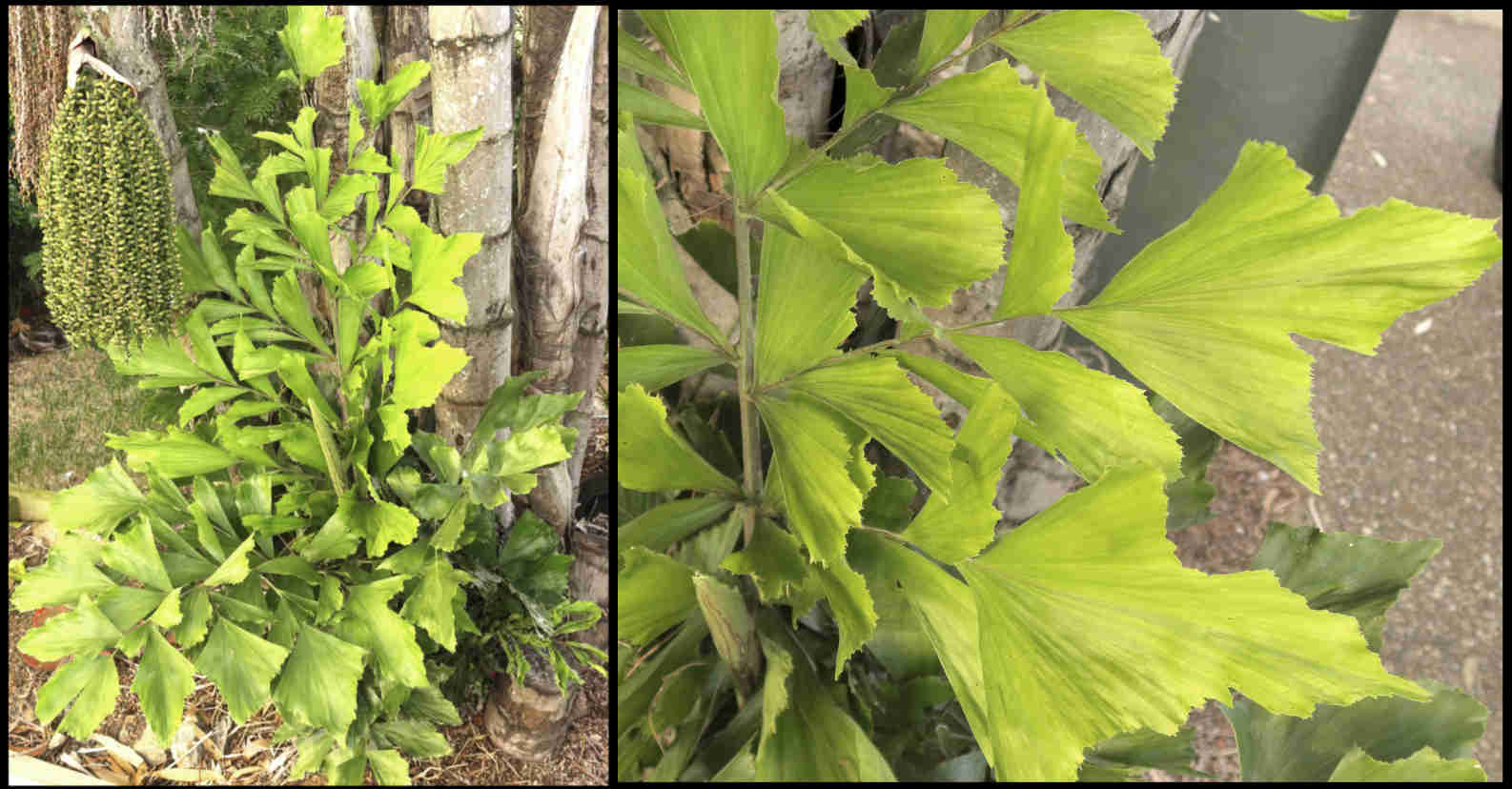Family Arecaceae > Subfamily Coryphoideae > Tribe Caryoteae.
There are 14 species of Fishtail palms native to S. China, India, S.E. Asia and N. Australia.
They are solitary or clustering with each palm having a single stem.
The columnar or swollen stem can be up to 25 m high.
Woody stems, up to 30 cm across have prominent ring scars where leaves have fallen.
Internodes are up to 45 cm and there is no crownshaft.
At the base of the stem are some thick and deformed adventitious roots.
Those underground, up to 8 m long can act as props.
Alternately arranged leaves can be along the stem or concentrated at the top.
Unlike other palms the leaves are bi-pinnate (twice divided).
For a time juvenile leaves are only once divided (pinnate).
Juvenile leaf blades are folded or pleated like a fan (plicate).
Each segment is ‘V’ shaped with the edges just touching the adjacent edges.
Adult leaves are on a short petiole or one up to 2 m long.
In cross section petioles are round or the upper surface is grooved.
The young stem and petiole have woolly brown or white hairs.
The wide base of the petiole forms an open or closed tube (sheath) down the stem.
Up to 1.5 m long the fibrous sheaths have dense hairs and scales.
Closed sheaths later split open on the side opposite the petiole.
Split sheaths remain on the stem for a long time held by thick dark fibres running between the edges.
The rachis or leaf midrib has pinnae (primary divisions) along each side.
Each pinna has pinnules (secondary divisions or leaflets) along each side.
The pinnules are wedge shaped with a very narrow base.
The straight or oblique end is ragged (erose).
There is no obvious midrib but a few prominent veins from the base.
There may be hairs or brown scales on the lower surface that fall off.
The 2 pinnules below the terminal one may have a small leaflet at the base.
Pendulous inflorescences are below or between the leaves.
The first to open is terminal then others open progressively down the stem.
When fruit on the bottom leaf, often at ground level are mature the stem dies.
The stem is replaced by 1 or 2 suckers at its base.
Up to 2 m long inflorescences are branched once or sometimes twice.
A few species branch 3 times or are a simple spike.
The long, thick, scaly peduncle is roughly circular in cross section.
On it are a small basal bract or prophyll and around 7 or 8 larger peduncular bracts (spathes).
The pendulous ultimate branches (rachillae) are spirally arranged on the midrib (rachis).
Each branch has a bare base with dense spirally arranged flowers down the rest.
Flowers are in groups of 3 with a central female and 2 lateral males.
Flowers have no pedicel and each group has a small bract and rounded floral bracteoles.
Male or staminate flowers are usually slightly elongated.
They have 3 free overlapping leathery sepals.
The 3 longer leathery petals are fused at the base.
There are 6 to over 100 stamens on short filaments that are occasionally fused at the base.
The linear anthers open sideways and there is no pistillode (aborted ovary).
Petals are mauve or yellow.
Male flowers open, release their pollen and fall before the female are mature.
The female flowers have 3 free leathery overlapping sepals.
The 3 leathery petals have a basal tube up to half their length.
Of the 3 fused carpels only 1 or 2 develop a fertile ovule.
There are up to 6 staminodes and nectary glands at the base of the ovary.
The tiny style has a 3-lobed stigma.
Fruit are a drupe with 1 seed or drupe-like with 2 seeds.
Up to 2 cm long the drupes have stigma remnants at the top.
The spherical green fruit mature to orange, red, purple then black.
Seeds are smooth or grooved.
J.F.


